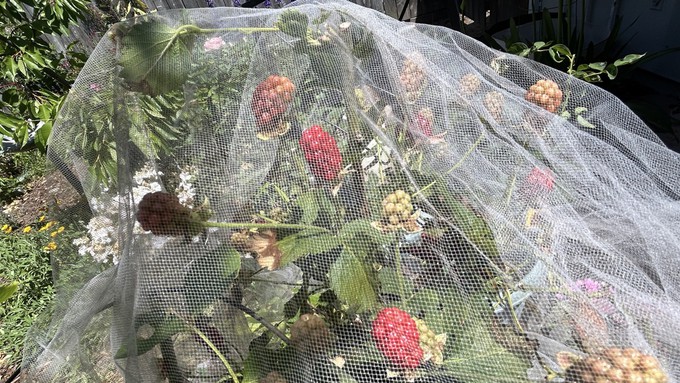
Be prepared for quick fixes and managing garden info

These ripening "Babycakes" blackberries are protected from birds and other critters with a length of tulle, which is lighter than bird netting and less likely to trap small birds. Kathy Morrison
Memorial Day weekend signals the start of summer around here, whatever the weather is doing at the time.
The next few days are perfect for putting together a summer tool kit -- garden hacks, in some cases -- that will get the plants and you through the worst that summer can dish out. (We hope, at least.)
1. A soil moisture meter. Preferably a good one, with a long spike, that will show the soil moisture level all the way down. (Example, if the top is wet, but 6 inches down is dry and 10 inches down is middling wet, you'll see that.) Years ago I got a tip about the Reotemp moisture meter, and I've become an advocate for it ever since. The meter runs on batteries, the sturdy spike is 17.5 inches long, and the information is viewed on top of the box, not on the side. Pricey but an invaluable tool.
Note: Many of the meters available out there only can be read from the side. Those are better than nothing, but the gardener needs to be very agile or very short to read ones stuck in the ground or a low pot.
Why it's important: Drowning plants is costly, and wastes water. Knowing whether the soil is really dry, or just looks dry on top, is crucial to proper irrigation levels. (There should be mulch on that soil too, by the way.)
2. Clothes pins or binder clips. Instant attachments are possible but not permanent with these handy items. I clip stems to stakes, shade cloth to cages, and tulle (see below) to itself when wrapping a plant.
3. Tulle. Lighter and cheaper than bird netting, this fabric (often used in wedding veils) is ideal for wrapping a berry-laden bush (using those clothes pins) or providing some quick cover for a newly repotted plant. Bonus: The fabric is washable and reusable.
4. Small wire trash bins. These are usually available cheaply at dollar stores, and they come in a few sizes. Perfect for protecting plants from marauding critters, especially held down with those metal staples used with landscape cloth.
5. Irrigation repair items. Even if someone else installed the dripline system, a gardener should have on hand enough pieces to make a quick repair. These should include plugs, a few feet of the 1/4-inch tubing, some connector pieces (straight and T-shape), and clamps for a quick shutoff of a blown-out line. Strong scissors also are good to have.
This kit came in handy when my housebound neighbor's dripline blew out right near the sidewalk, sending water pouring down the gutter at 7 a.m. Once the water shut off, I was able to add a new connector and reattach the line, without her having to call a repair person.
Other items I've found useful over the years:
-- A broken umbrella that still can be opened, to protect a plant suddenly being cooked by the sun.
-- Unused or too-small tomato cages. Open the umbrella and place it on top of the cage, than position the cage over the suffering plant.
-- Square plant flats. These also work for quick shade; use it with a cage just like the umbrella/cage combo.
-- Plastic gelato containers with lids. Ideal for storing seed pods (such as for California poppies). The jar also makes a great scoop for fertilizer.
-- Newsprint or old newspaper sections. Crumpled, the paper can provide extra insulation around a hot pot, especially if it's set inside an empty larger one. I use sheets of paper inside my worm bin for insulation on top of the worms. Shredded paper also can be used as emergency mulch.
Comments
0 comments have been posted.Sacramento Digs Gardening to your inbox.
Sites We Like
Garden Checklist for week of July 21
Your garden needs you!
* Keep your vegetable garden watered, mulched and weeded. Water before 8 a.m. to reduce the chance of fungal infection and to conserve moisture.
* Feed vegetable plants bone meal, rock phosphate or other fertilizers high in phosphate to stimulate more blooms and fruiting. (But wait until daily high temperatures drop out of the 100s.)
* Don’t let tomatoes wilt or dry out completely. Give tomatoes a deep watering two to three times a week.
* Harvest vegetables promptly to encourage plants to produce more. Squash especially tends to grow rapidly in hot weather. Keep an eye on zucchini.
* Pinch back chrysanthemums for bushy plants and more flowers in September.
* Remove spent flowers from roses, daylilies and other bloomers as they finish flowering.
* Pinch off blooms from basil so the plant will grow more leaves.
* Cut back lavender after flowering to promote a second bloom.
* It's not too late to add a splash of color. Plant petunias, snapdragons, zinnias and marigolds.
* From seed, plant corn, pumpkins, radishes, winter squash and sunflowers.